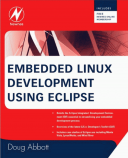Книга: Embedded Linux development using Eclipse
Summary
Summary
Plug-ins, written in Java, are the mechanism for extending the functionality of Eclipse. The Plug-in Development Environment (PDE), itself a collection of plug-ins, provides intuitive graphical tools to aid the process of plug-in development.
Eclipse defines some 200 extension points where the basic platform can be enhanced by plugging in extensions. The role of a plug-in, then, is to implement extensions.
Normal plug-ins execute as extensions of the Eclipse workbench. The Rich Client Platform (RCP) provides a mechanism that allows you to use the same plug-in development environment to build stand-alone Java applications that utilize Eclipse UI features. Another project, the embedded Rich Client Platform (eRCP), brings the same capability to embedded devices.
The next chapter looks at a couple of advanced features of Eclipse that are also of value to embedded developers, source code control using CVS, and software design modeling using UML.




